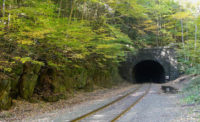Redevelopment of Lower Manhattan’s World Trade Center site has been beset with problems: design changes, funding problems, and political squabbling. And, there wasn’t even much to see at the site for nearly a decade, save for the tops of cranes and a few rumbling trucks, as a tall fence wrapped the perimeter.

But nine years after the September 11 attacks, there finally are tangible signs of progress. A memorial and a tree-filled plaza will be completed next year, in time for the 10th anniversary. The museum will open in 2012. And the steel framing of One World Trade Center—now at 36 stories—is clearly visible above the fence.
While other aspects of the development, including four additional towers and a transit hub, won’t be finished for years, officials say the project finally has momentum.
“At the end of the day we’re going to have a showpiece here that we are enormously proud of,” said developer Larry Silverstein on Tuesday afternoon, at a press conference called to update the public on what’s happened in the past year. He was joined by Governor David Paterson, Mayor Michael Bloomberg, and representatives of the Port Authority of New York and New Jersey, the transportation agency that owns the land.
The officials spoke on the 10th floor of what is perhaps Ground Zero’s biggest success story so far: Seven World Trade, a 52-story Skidmore Owings & Merrill-designed office building that opened in 2006. And while all the speakers praised what construction they could see outside the floor’s tall windows, many also acknowledged the start-stop nature of the process thus far.
“While nothing happens in democracy as quickly as we would like,” Mayor Bloomberg said, “the truth of the matter is, democracy does get you to the right place, even if it’s sometimes painful and it sometimes takes some time.”
Here’s a look at the key elements of the site:
The Memorial
The memorial, designed by Michael Arad and Peter Walker, will feature two 176-by-176-foot pools, whose square shapes mimic the footprints of the Twin Towers. Water will cascade down the sides of the 30-foot-deep pools, whose walls will be inscribed with victims’ names. They will be the largest artificial waterfalls in America, officials say.
As of early September, 65 percent of the granite that lines the pools was installed, and all of the structure’s steel (8,150 tons) was in place. In addition, 75 percent of its concrete has been poured, says Joe Daniels, president of the National 9/11 Memorial & Museum, which will run the site. Pump rooms for the waterfalls are now being fitted, Daniels adds.
Work on the surrounding plaza also is moving along. In August, workers planted 16 of the 438 swamp white oaks planned for the site. They are being grown off-site to a height of about 30 feet and will rise an additional 50 or so feet. All of the trees will come from New York, Pennsylvania, and Virginia—three places prominently affected by the September 11 attacks.
The Museum
The seven-story, 120,000-square-foot museum, designed by Davis Brody Bond Aedas, will be located underground, with its lowest level sitting on bedrock 70 feet down. Visitors will enter through a pavilion and gradually descend into the raw, cavernous space via a gently sloping ramp. Ceiling heights in the cast-in-place concrete building will vary from 26 to 60 feet.
The museum will include remnants of the Twin Towers and September 11, such as a 60-by-60-foot original slurry wall, a fire truck and ambulance damaged during the attacks, and a 37-foot-tall steel column that survived the building collapse and became an impromptu memorial, covered in tributes. “This is a museum without a façade,” notes Steven Davis, FAIA, managing partner at New York-based Davis Brody Bond Aedas. “Traditionally, the icon houses the exhibit. Here, the icon is the exhibit.”
The museum also will include a facility run by the New York medical examiner’s office to continue processing unidentified human remains. Approximately 3,000 people died on September 11—2,600 of them in New York — and only 40 percent of families received remains, notes Alice Greenwald, director of the National 9/11 Memorial & Museum.



Post a comment to this article
Report Abusive Comment